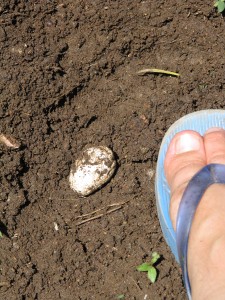Stinkhorn!

There was a surprise in our garden this afternoon. We were weeding and planting a flower seed mixture around the back of the house, and suddenly my daughter excitedly shouted, “Stinkhorn!” I didn’t take offence. I was excited, too. What she was referring to was a reddish, odd-looking fungus that had emerged from the ground next to a rose bush. This fungus makes a rather unpleasant odor, which attracts flies who then carry off the spores. A pretty tricky plant. We had our first and only stinkhorn emerge last year in a different part of our yard, and I was afraid that with all the walking and weeding done in that area, that it wouldn’t be back. Silly me. The fungus was traveling!

Then shortly after this discovery and only a few feet from it, I was digging up weeds and found what I thought was a reptile egg. We thought that maybe it was an egg from Mrs. Sabatini, the Western pond turtle that we found on our property and released into our upper pond, never to be seen again. Or perhaps a snake egg.

When I felt it, however, it was firm and had a little give to it, like it was made of soft rubber. My daughter figured it out. She had read where the stinkhorn spores grow into an egg-shaped, um, thingy, which breaks open underground revealing the slimy gooey part which then pushes up through the ground and begins stinking. The slimy part has the spores on it.

Fungus is incredible and wonderful. The threads of fungus hold together the soil, feed us, medicate us and yet we know so little about them. An incredible book to read is Mycelium Running: how mushrooms can help save the world, by Paul Stamets. Although most people wouldn’t welcome a stinkhorn into their perennial border, we think it is very cool, as long as there aren’t too many of them!